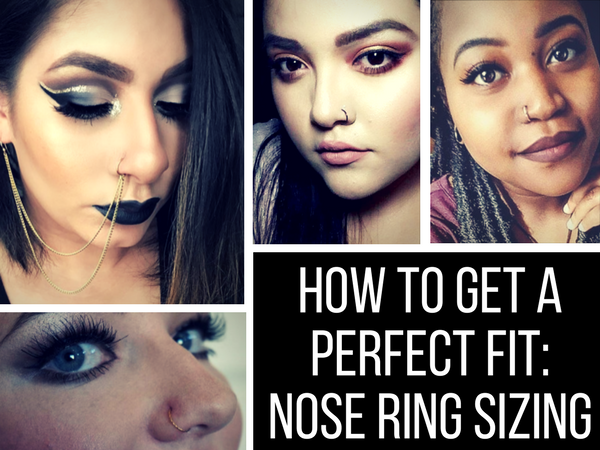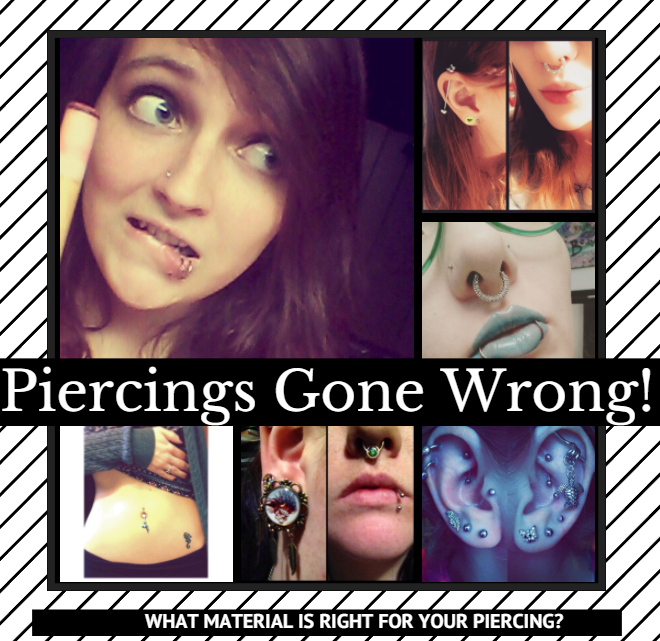Nose piercings are one of the most common body modifications in the world - it's no wonder that so much different terminology is used to describe these piercings. There are more options than ever when it comes to expressing yourself with your jewelry, but with so many different sizes and types of body jewelry, there is bound to be some confusion at one time or another. Body Candy is here to be your go-to guide for becoming an expert in nose and nostril piercing!
This post will focus on the many ways to measure and size nose rings. We'll talk about the difference between gauge, length, size, rise, and diameter, and how they apply to the different styles of nose and nostril jewelry. By the end of this blog, you'll be able to pick out the correct size and style of body jewelry that will work best in your own, unique nose piercing.
Step 1: Find Your Gauge
The "gauge" of body jewelry refers to the thickness of the item, which directly correlates to the needle size that is used to pierce you.
Everyone's nose is different; your local piercing professional will choose an appropriate size gauge to accommodate the size and shape of your nose. Since there are so many differently sized noses, there are also several different gauge sizes made to suit everyone's unique anatomy and aesthetic.
The gauge of the item is extremely important to the fit of the item. Standard sizing for nose rings is normally a 20 gauge; this means the thickness of the portion that goes through the piercing is approximately .8 millimeters.
Different Gauge Sizes:

22 Gauge (.6mm)
Piercings done in India, the Middle East, or very select areas of the US, UK, Australia, or Europe may use the tiniest size: 22 gauge. This is normally considered a specialty size that may need to be handcrafted by an artisan.20 Gauge (.8mm)
This is the smallest gauge that most body jewelry will come in and is used almost exclusively in nose piercings. You’ll find that most nose ring styles come in this gauge.18 Gauge (1mm)
This is the gauge used for larger sizes of nose piercings. It is slightly larger than the 20 gauge, but this size will still provide you with countless fashionable options.
There are a few exceptions, but for the most part, these common gauge sizes are what you'll be working with when it comes to your nostril piercings. Knowing the correct gauge size is incredibly important - you can make sure your jewelry will fit comfortably without slipping out.
Step 2: Find Your Proper Length or Diameter
The "length" (sometimes referred to as the "rise") of nose rings is measured from the base of the gem or decoration to the beginning of the curve, bend, or bulbous end. This portion of the jewelry is also known as the “wearable surface,” as it refers to the part of the item that will actually be worn inside the piercing.
The average length of a nose ring is about 6 millimeters, but for those who have slightly thinner or thicker nasal cartilage, 5mm and 7mm lengths are also available.
Unless your nose is very dainty or larger than average, any of these sizes will likely fit in your nose piercing. For a truly perfect and comfortable fit, getting an ideal length measurement from your professional piercer is a good idea.
Fishtail Nose Rings:
Piercings that are done in non-traditional areas of the nostril, or piercings that need to be specially customized to fit a unique nose can be created from a fishtail nose ring.
First, the piercer will use a special device to measure your nose. Next, they'll bend the long end of the fishtail nose ring into a size that's custom-fit to your nose.

The two most common types of bends are the nose screw, a standard type of nose ring that looks like a corkscrew, and the L-shape, which literally leaves the item in the shape of an uppercase L.
"Diameter" is the distance between the inside edges of the nose hoop at its largest point. For nose hoops, the diameter is measured instead of the length.
Depending on how high up your piercing is and how large or small your nostril is, an incorrect diameter can end up looking a little funky. A properly measured diameter will look the most aesthetically pleasing, so it's very important to measure correctly!
The two most common diameter sizes for nose hoops are 5/16″ (8mm) and 3/8″ (10mm). Individuals with larger noses or with large-gauge nose piercings may need rings with a larger diameter size. In this case, if possible, measuring a hoop that already fits can be a good benchmark.
If you need a size that isn’t commonly sold on our site, visit your local professional piercer. They will measure both your jewelry and your nose and can recommend a size that will work for you.
Step 3: Pick Your Decoration and/or Gem

Here's the fun part! The best part of getting your nose pierced is picking out a sparkly gem or decoration to show off. Depending on the look you want and the size of your nose, this measurement can be rather important and is often overlooked.
Body Candy's nose rings, most notably our solid gold options, are set in a low profile setting with a flat bottom to ensure the ring sits flush to the nose. Each stone has its own "seat" (a notch cut into the setting by a highly skilled craftsman) that fits each individual stone. This not only ensures a sleek aesthetic look, but also makes it less likely you'll get your jewelry caught on something.
The gems and settings on nose rings start as small as 1.2 to 1.6mm - these sizes are known as micro nose rings. Gems and settings can go up to about 3mm in size. Decorative shapes can be even larger, sometimes measuring up to 6 or 7mm (about 1/4") wide.
For persons with petite noses, standard 2mm sized gems can look a little bit over-sized. Same goes for individuals with larger nostrils - a tiny micro nose ring may not get the attention you and your nose piercing deserve.
Troubleshooting
Is your nose ring's fit a little off? What happens when you find a nose ring you like but it doesn't seem to fit right?
We've answered three very common issues that will help with troubleshooting why your nose ring isn't fitting correctly. These should be your first line of defense when combating the frustration of finding a perfect nose ring style with an unfortunately imperfect fit.
Problem #1: "My nose ring sticks up a bit and leaves a gap between the stud and my skin instead of laying flat against my nose."
Solution: If the gem or decorative end of your nose ring sticks up too far from your nose, you’ll probably need to check the rise of your nose jewelry.
The "rise" of a nose ring is the length of the portion between the base of the gem/decorative end (the end that is visible outside of your nose) and the curve of the screw or L-shape.
Most of these kinds of nose rings have a rise of either 6 or 7 millimeters, but for those who have slightly thinner nostrils, a 5-millimeter rise may be necessary for a proper fit in your piercing.
Problem #2: "The corkscrew portion of my nose screw sticks out and is visible from the bottom of my nostril."
Solution: When this issue occurs, it could mean you either have a nose that is slightly smaller than average or that your piercing lays slightly further down on your nostril than usual. Neither of these are a bad thing, but if this is true for you, finding the right size nose screw may be difficult.
Switching to a nose bone style is a quick and easy fix. If that isn’t a comfortable enough option for you, then try a screw with a less pronounced curve in its design or one that doesn’t make a full revolution to solve the problem.
Problem #3: "How can I get a nose hoop that will fit without looking like it's too big for my nostril? I want to wear this type of nose jewelry, but my nose piercing is a little higher on my nostril than standard."
Solution: If regular nose hoops don't seem to be big enough for your piercing, but larger, universal circular rings (such as seamless segment rings) stick out from your piercing too much, a good solution is getting a custom nose ring.
In this case, you should purchase a fishtail nose ring, which is extra-long and straight. Bring your fishtail nose ring to your local, professional piercer - they will measure your nose and create a custom hoop (or other style nose ring) that is bent into a unique fit that works for you.














